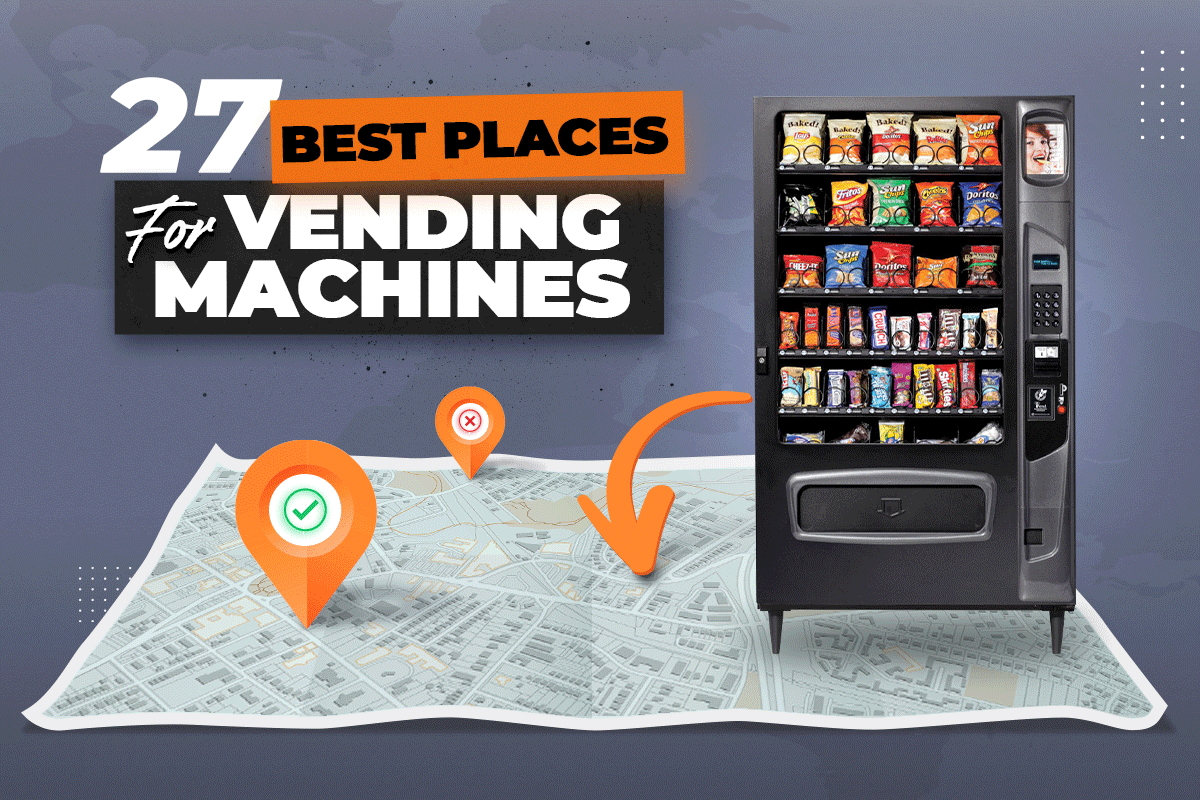If you’re looking to get into the vending machine business, you’ve come to the right spot. We analyzed existing resources and talked to the owner of Hill Vending to find out the best vending machine locations. Get ready to find out where to put vending machines!
Adam Hill bought his first vending machine route for $120K in 2014 and grew his vending machine business to $600K annually. He’s even started his own vending machine training course with the UpFlip Academy. In our interview, he explained there are four keys to vending machine business success:
- Location
- Machines
- Service
- Pricing
Adam said:
- Three Ways of Finding Investing in Vending Machines
- How to Find Locations for Vending Machines
- Best Vending Machine Locations
Click any of the above text to jump to that section of the article.
3 Ways of Investing in Vending Machines
Adam Hill told us:
He went on to explain there are two main ways to choose a vending machine location:
- Buy an Existing Route
- Perform B2B Sales
Check out our interview about the vending machine industry below:
In addition to the two ways that Adam mentioned, we’ll also discuss buying a vending machine franchise. Keep reading to learn how to buy an existing vending machine route.
Buy Vending Machine Route
Adam suggests buying an existing vending machine business from a business owner because:
As you review a potential route for purchase, you’ll want to ask lots of questions about the following:
- Vending machine locations
- Vending machine equipment
- Vending machine prices
- The relationships with property owners
Adam discusses all that and more in our Vending Machine Class. Sign up for early access.
Adam explained:
Next, we’ll discuss cold-calling businesses.
Perform B2B Sales
Adam also discussed going to businesses and negotiating to place vending machines on their properties. He explained that this can be difficult because existing locations frequently have a service contract. He also gave tips on the best person to talk to:
He also explained why you shouldn’t approach the general manager or property owner unless you are dealing with a solo entrepreneur.
Check out our in-depth walkthrough on the vending machine industry. Next, we’ll discuss vending machine franchises.
Buy a Vending Machine Franchise
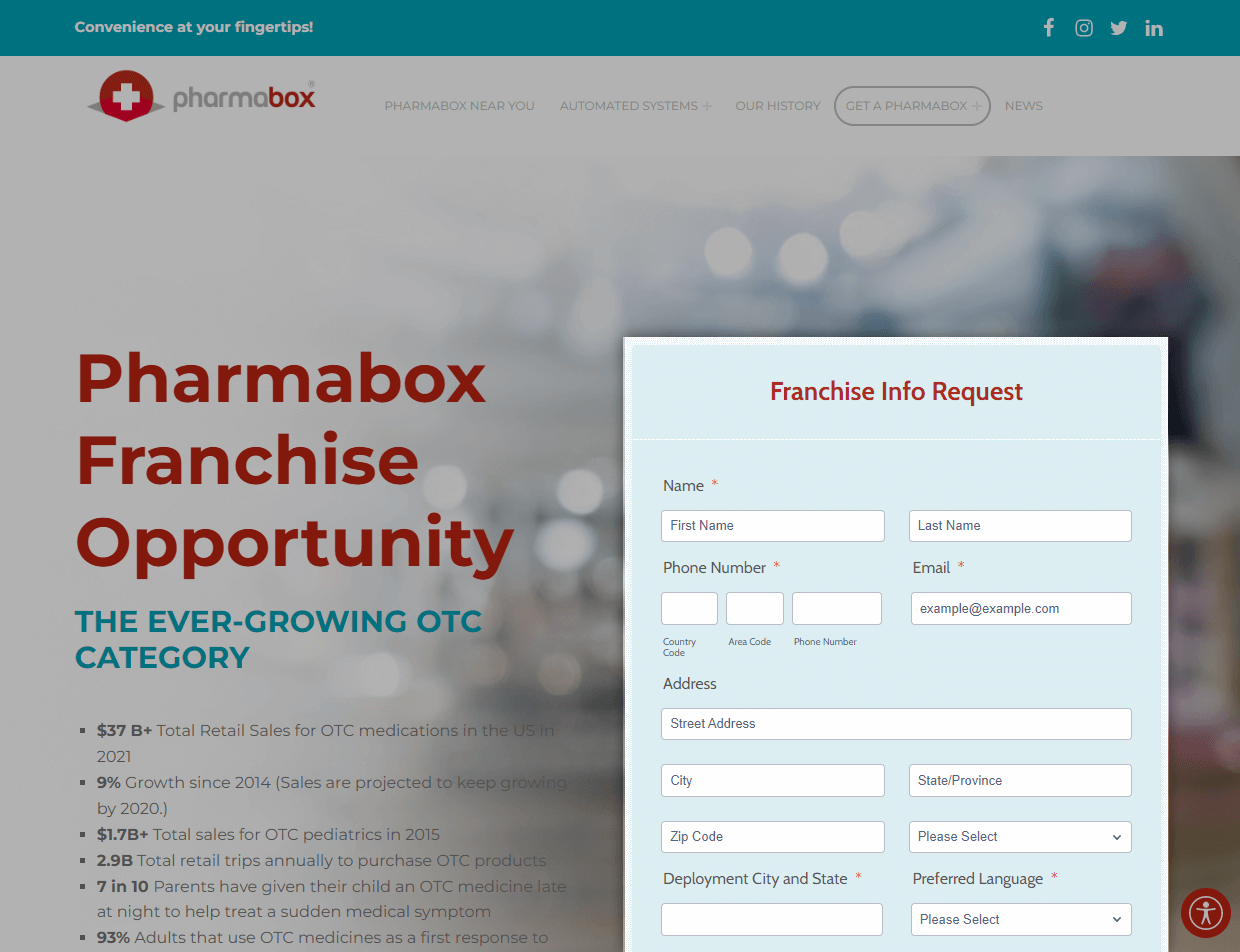
Vending machine owners can also use the franchise model to start a vending machine business. This vending machine business model is often used by major vending machines companies like Coca-Cola and Pepsi. In addition, other vending companies like Pharmabox use this model. There are two basic models that these franchising opportunities use:
- Franchise: You can purchase the vending equipment and the rights to use the vending business name in exchange for licensing rights.
- Route Owner: You become a partner of the company and manage a service route for the company. These options are good for entry into the vending business because many of the major decisions are made for you.
Where Can I Learn How to Start a Vending Machine Business?
Check out our other blogs about vending machines including:
- Start A Vending Business
- Vending Machine Types
- Best Vending Machines
- Getting Vending Machine Licenses
Then sign up for our Vending Machine Bootcamp.
Where Can I Put a Vending Machine Near Me?

You’ll want to consider the elements of choosing a location for your vending machines. The best locations for vending machines have the following characteristics:
- Where can I legally put a machine?
- Type of vending machine business
- Lots of foot traffic
- People congregating at all hours
- Distance from you
- Easy accessibility to the vending machine
- Infrequent ownership changes
Let’s look at each of these a little more.
Where Can I Legally Put a Vending Machine?
You can legally put a vending machine anywhere you have an agreement with a property owner. There may be licensing requirements depending on your location, but as long as you follow the laws and have an agreement in place, you can put your vending machines in almost any location.
Type of Vending Machine Business

The vending industry covers all types of products. Your ideal location will depend on what you sell in your vending machines. The right location for a snack machine is almost anywhere (except maybe the lines in amusement parks), but maybe you shouldn’t offer energy drinks in the waiting room in medical centers.
Adam told us:
Check out our blog about different types of vending machines to find the types that most interest you.
Foot Traffic
The number of people passing a vending machine impacts whether you have profitable locations. Some locations have less than 50 people passing the vending machine daily, while airports can achieve up to 76 million travelers per day.
Hours of Operation
A business that is busy 24/7 like a hospital is likely to be a better place for a vending machine than somewhere like an apartment complex pool that closes for half the day.
Distance from You
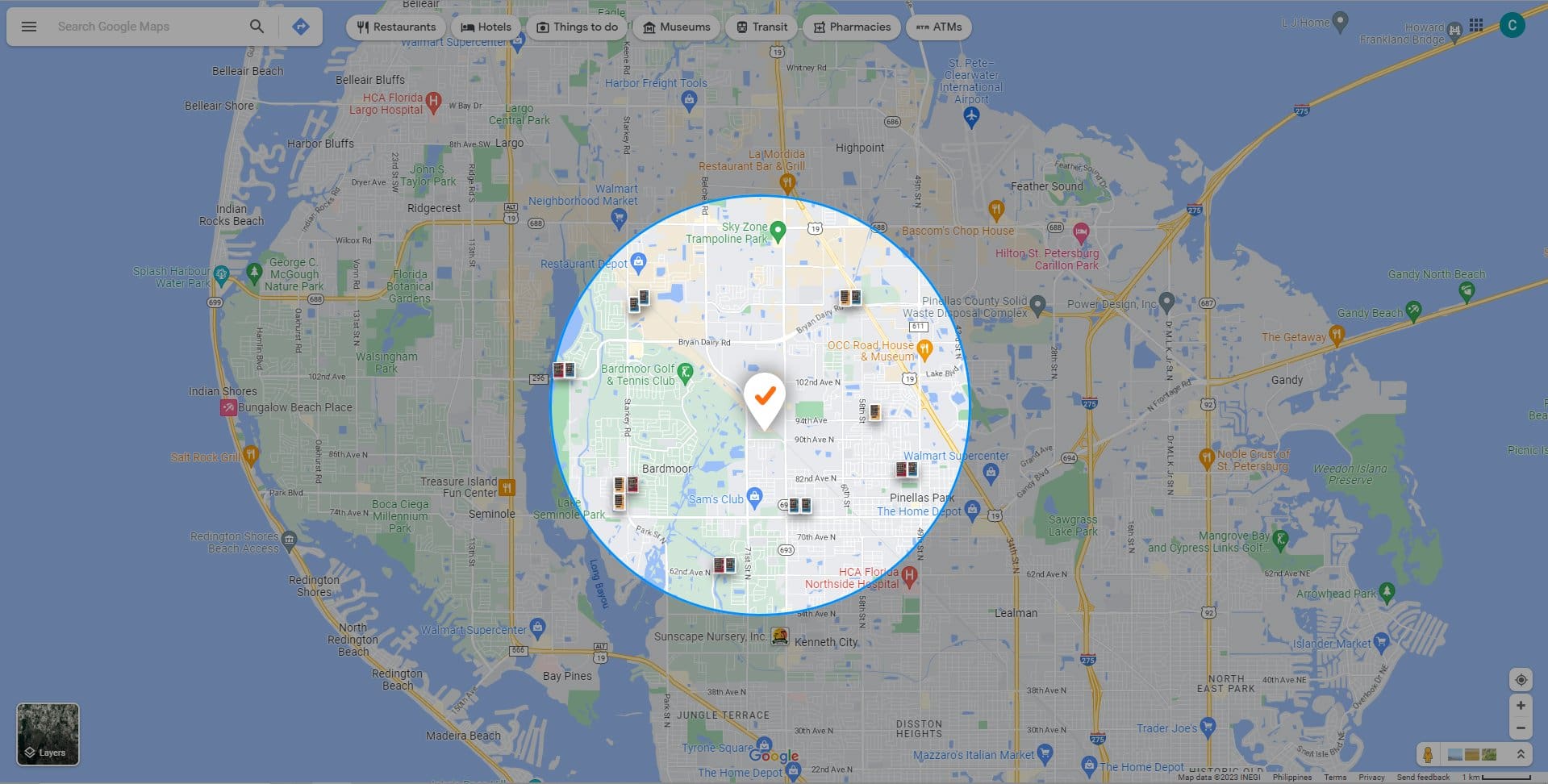
You’ll want to make sure that your route is easy to get to regularly. The further you have to drive, the more business expenses you’ll have.
Accessibility to the Vending Machine
It is harder to sell products if people can’t easily access the vending machines. Providing easy access means:
- Three feet of clearance in the front
- NOT disrupting the flow of traffic
- Making it easily viewable
Sometimes there will be a suitable location in areas that are off the beaten path. For instance, shopping malls and casinos often have hallways with a bathroom and drink machines. These machines regularly do well because people buy snacks or sports drinks while waiting for their friends.
Infrequent Ownership Changes
You probably want to avoid businesses where the property owner frequently changes. You don’t want to enter into a vending machine placement contract, then have to renegotiate with a new owner soon afterward.
Next, we’ll discuss some of the best locations for vending machines.
Best Places to Put Vending Machines
We’ve compiled some data on the best places to put a vending machine. We’ll cover:
- Airports
- Bus and Train Stations
- Hospitals and Care Facilities
- Warehouses
- Office Buildings
- Apartment Complexes
- Dealerships
- Hotels
- Gyms
- Schools
- Dorms
- Retail Stores
- Gas Stations
- Shopping Centers
- Amusement Parks
- Conference Centers
- Car Washes
Consider some of the following vending machine location ideas.
#1. Airports Are the Best Locations for Vending Machines

The top 10 airports have more than 100,000 people passing each day. Your vending machine business is sure to make some great revenue. You’ll need lots of machines and potentially a full staff to keep up with the foot traffic in the best locations. If you can’t secure one of the best locations, there are plenty of other options. A business owner that even secures a slower airport has over 600 people pass their vending locations every day.
#2. Where Can I Put My Vending Machine? Bus and Train Stations
Placing vending machines at train and bus stations can be highly profitable.
Amtrak, the largest U.S train station operator, carries more than 22.9 million riders in 160 communities. That comes out to 400 riders daily per community, but the highest travel rates see more than 34,000 people per day.
Meanwhile, Greyhound Lines serves nearly 16 million passengers across 135 markets, or over 325 people per bus station daily.
If you can negotiate a deal with the station property owners, they are a good place to put a vending machine.
Turn Vending Into a $58K/Month Business Working Two Days a Week! |
|
| Want to own a business that’s both profitable and flexible? Adam Hill’s vending business makes $58K/month while he works just two days a week. Now he’s revealing his exact process to help you do the same. In his 66-lesson UpFlip Academy course, you’ll learn how to spot high-profit locations, negotiate better deals, and implement systems to maximize your profits. With Adam’s expertise, you’ll learn how to grow your own vending empire without relying on trial and error. | |
| Join the UpFlip Academy! | |
#3. Hospitals and Care Facilities Are Good Locations

Hospitals and long-term care facilities are also high-volume places for vending operators. According to the Center for Disease Control, the average person goes to the doctor 2.5 times per year, and such facilities house nearly 240,000 people. There are three common areas to include vending machines:
- Waiting Rooms
- Break Rooms
- Reception Areas
Waiting Rooms
A waiting room is a great place to put a vending machine with healthy snacks like protein bars and granola bars. You’ll probably do well with drink machines as well. Provide vending needs for people waiting for their families and make a nice profit doing it.
Break Rooms
Employees need a place to get an easy snack or drink and a vending machine in the break room can be highly profitable. You’ll get a steady flow of revenue from these 24/7 businesses.
Reception Desk
Placing a vending machine near the nurses’ desks is a great way to make a huge profit because you can serve patients, visitors, and staff all from one machine.
#4. Warehouses Are Good Places to Put Vending Machines

Another good place to put vending machines is in warehouses. Warehouses are commonly used as distribution centers, manufacturing facilities, and industrial parks. These businesses generally employ hundreds or thousands of people and operate 24/7. State laws typically guarantee two 15-minute breaks and a 30-minute break per shift. That means vending machines in the break room do well because employees don’t have time to leave the premises.
#5. Where Can I Put a Vending Machine? Offices
A vending business can be highly profitable if you place machines in office buildings with 50 or more employees. Employees get hungry and thirsty throughout the day and vending machines provide options for people who forgot to bring something from home. That makes an office space a great location for vending machines.
#6. Where to Put a Vending Machine: Apartment Complexes
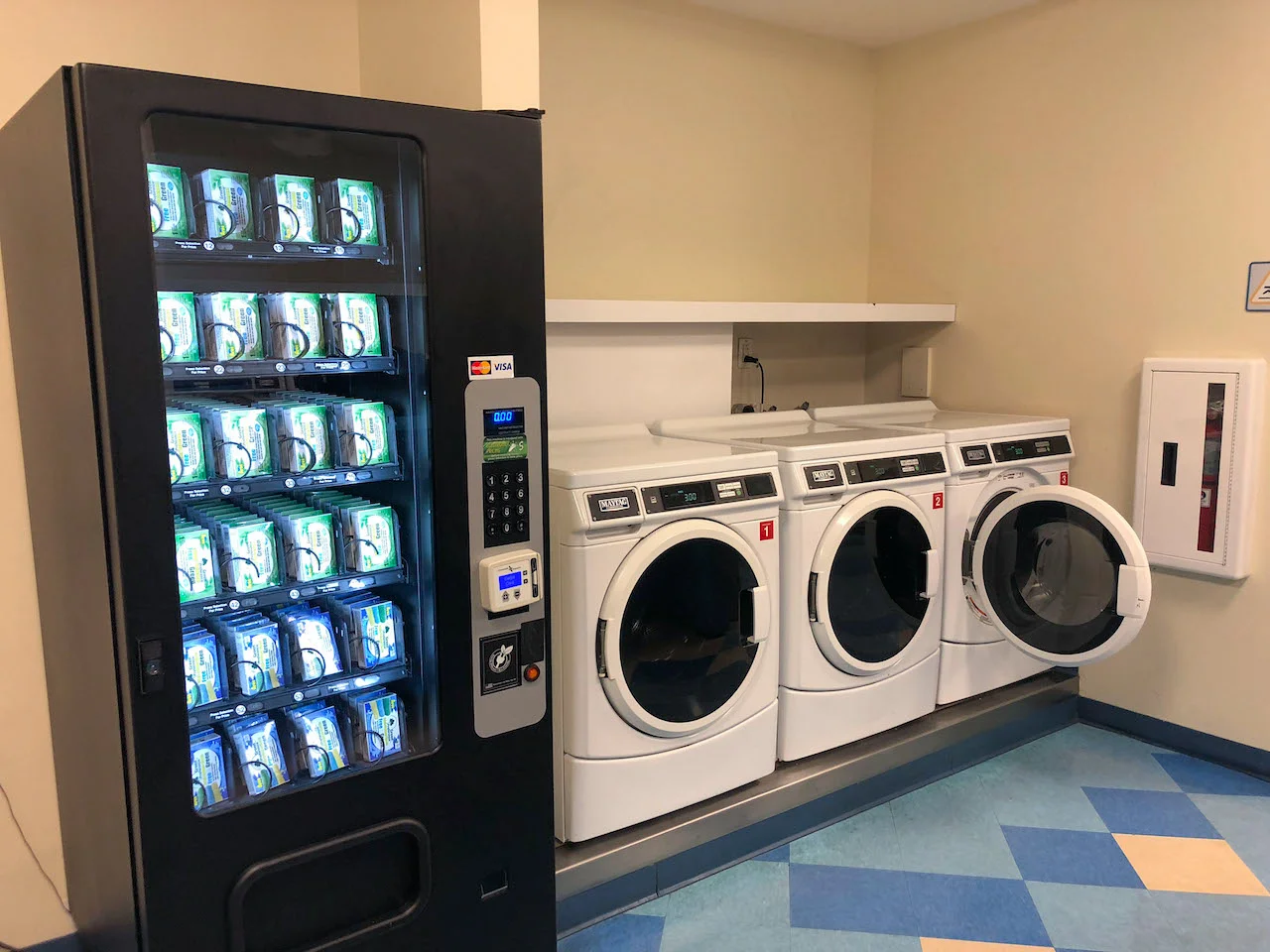
Apartment complexes are great locations for vending machines. Each complex is different, but many have multiple locations for people to pass a machine regularly including:
- Laundry Rooms
- Common Areas
- Playgrounds and Parks
- Party Rooms
- Gyms
- Mailbox Areas
- Pools
Adam warned us:
Keep reading to find out why a car dealership is on the best vending machine location list.
#7. Where Can I Put My Vending Machines? Car Dealerships
Car dealerships make great locations for beverage services because they have lots of employees, plus the average consumer spends nearly three to four hours buying a car and several hours waiting every time they take the car for service.
#8. Best Location for Vending Machine: Hotels
Guests in a hotel or motel will want a quick snack or drink even if they don’t want a full meal. Once you negotiate deals with these properties, you might wonder where to put your vending machine. You can place your vending machine:
- Near the front desk
- On each floor near the ice machine (You could even offer to supply and maintain the ice machines, too.)
- In pool areas
- In the food court
Given that hotels are 24/7, they can be top-grossing locations.
#9. Gyms Might Be Ideal Locations
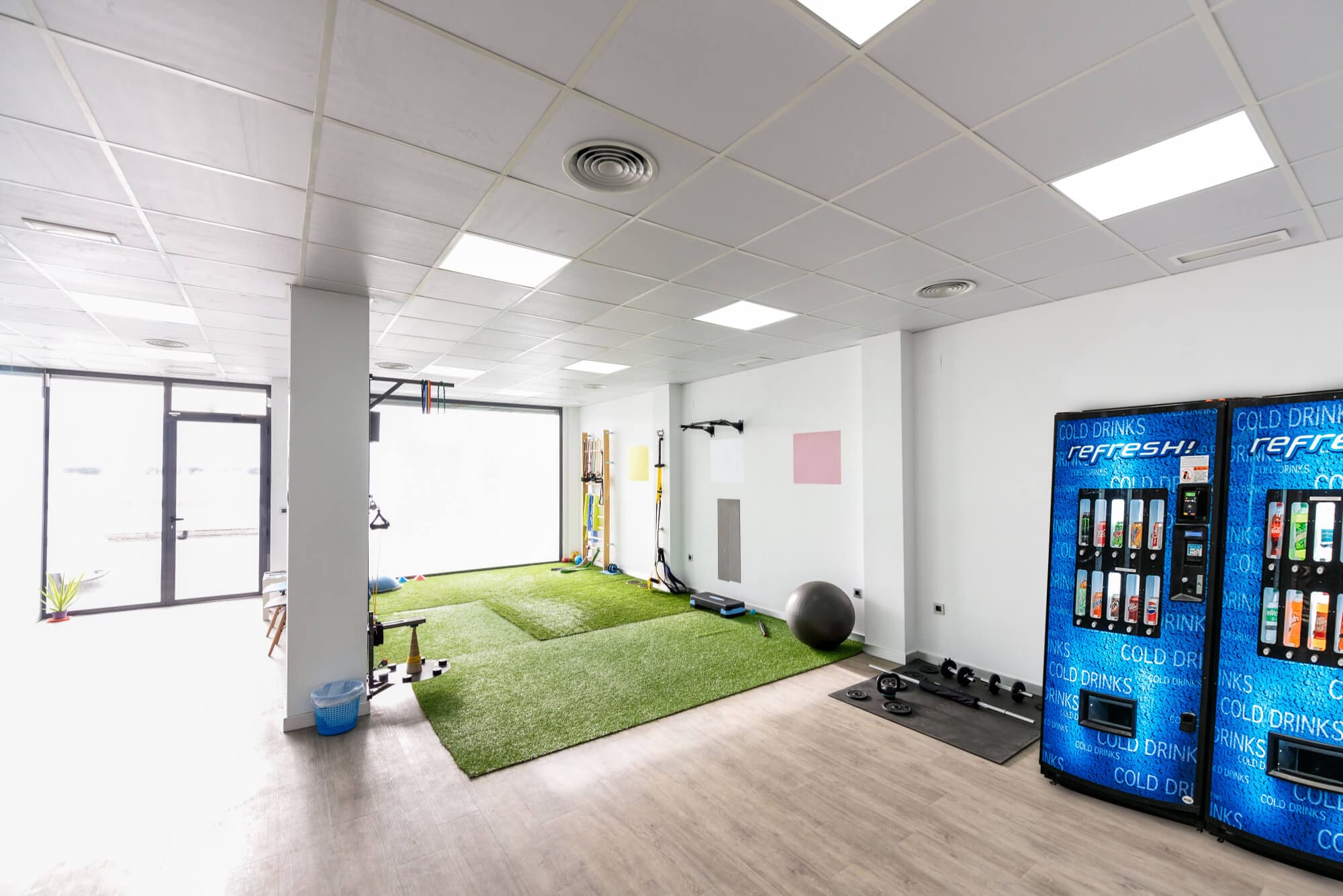
Gyms and fitness centers are full of people working out. Where can you put a vending machine in a gym?
Try the following locations to give your machines a competitive edge:
- Lobby
- Locker Rooms
- Cardio Room
- Weight Rooms
Make sure to offer healthy snacks, water, and sports drinks. They don’t expect a full meal because that would weigh them down.
#10. Want High Foot Traffic? Try Schools, Community Colleges, and Universities

Schools, community colleges, and universities are always busy. That makes them a great place for vending machines. Just to give you an idea there are:
- 130,930 K-12 Schools with an average enrollment of 528 students.
- 4,000 colleges with an average enrollment of nearly 4,000 enrolled students.
States often have regulations about the type of quick snack options you can provide on school property. You’ll also need to be ADA compliant.
Are vending machines a good investment on college campuses?
The answer for many colleges is probably no. Many private institutions are seeing large declines in enrollment. Some state-funded schools are doing well, but on average they are facing year-over-year declines (see enrolled students link above). If you can negotiate deals in these locations, you may find greater success because they have growing populations of college enrollment:
- New Hampshire: 149.6%
- Utah: 54.7%
- Idaho: 44.4%
- Delaware: 6.19%
- District of Columbia: 5.97%
- Texas: 4.27%
Make sure to research the enrollment trends and percent of students who are online only. Every school releases information about this. Keep reading for another exception to the decline in foot traffic at colleges.
#11. Dorms: Best Vending Machine Locations
If a college has a dorm, you might want to figure out how to get vending machine locations into it and the rest of the campus. Dorms tend to have lots of people at them 24/7. Don’t forget to integrate your card machine with their meal plans to get even better revenue.
#12. Retail Locations are Great Vending Machine Locations
A retail store has two primary areas vending machines make sense:
- Front of the Store
- Break Rooms
The front of the store should be things that people run in to get quickly like personal hygiene products, while the break rooms would be perfect for snack machines and drink machines.
#13. Gas Stations Use Vending Machines Too!

A gas station needs a variety of vending machines, but most machines will not be coin operated. They may be from one vendor or multiple vendors. They will typically include:
- Coolers
- Drink Dispensers
- Food Heating Dispensers
- Gas Vending Machines
- Water Vending Machines
- Ice Vending Machines
It’s difficult to be all things to all people so if you choose to go with gas stations, start with one type of vending option and go from there.
#14. Shopping Centers are Good Vending Machine Locations
A shopping center is another great place for vending machines. You can place a vending machine:
- In food courts
- Near rest rooms
- By entrances and exits
- Near popular stores
#15. Amusement Parks are Great Locations for Machine Vending
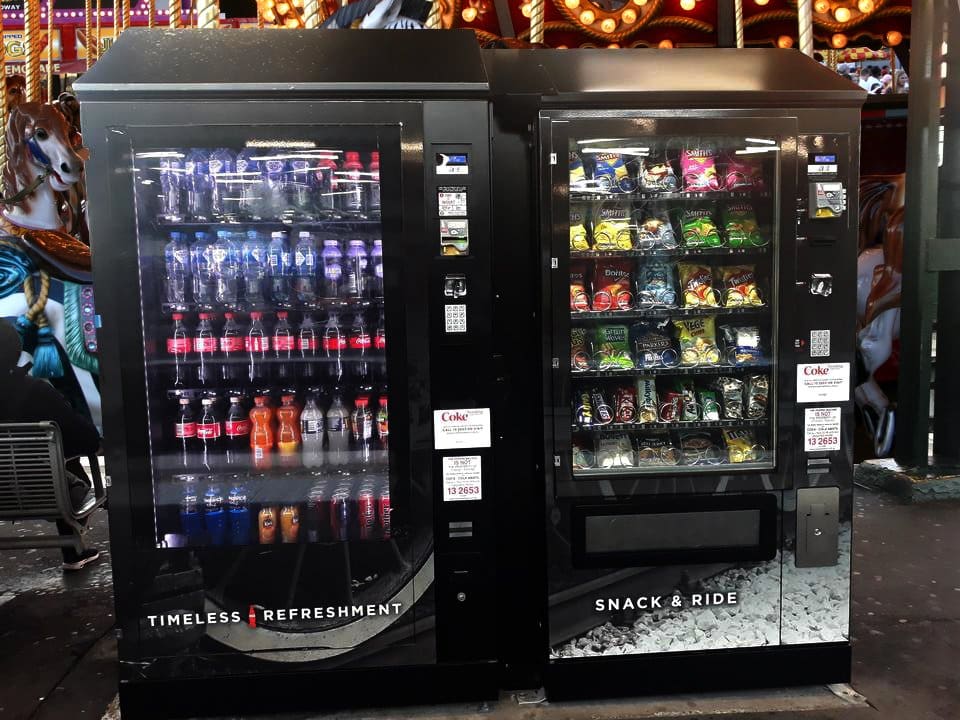
If there’s an amusement park in your area, you can find places to put vending machines like:
- Drink Machines
- Snack Machines
- Cooked Food Vending Machines
- Claw Machines
- Game Machines
They’ll be outside, so they’ll have more wear and tear. A sports complex will also have similar needs.
#16. Conference Centers Need Vending Machines
These buildings make great locations for vending machines because they host meetings and conventions where people spend most of their days. You can place vending machines that offer:
- Drinks
- Snacks
- Hot or Cold Meals
- Electronics (people always forget their phone chargers)
- Medicine
- Personal Hygiene Products
#17. Car Washes

A car wash is a great place for a vending machine because people often want a drink. There are two types of car washes:
- Self-Service: The customer drives the car through an automated wash, then cleans the interior of the car themselves. You’d want vending machines near the cleaning stations. You might also want to offer cleaning product vending machines.
- Employee Ran: Employees wash and clean the interior of the car while the customer waits. You’d want the vending machine in the waiting room.
#18. Restaurants Use Vending Machines to Save Time
If a restaurant has popular items that will stay good for a decent amount of time, it might boost business to offer them in vending machines. This is especially so in a location that makes it easy to pick up food on the way home from work. Check out this Pecan Pie Vending Machine outside Berdoll’s Farm:
View this post on Instagram
#19. Health Food Stores
Offer to place a vending machine outside of a health food store and help them sell their products even when they’re closed. Communities that often sponsor athletic events that involve cycling and running might especially benefit from after hours service.
#20. Hair Salons
Salons are bustling with activity and people will often get hungry or thirsty during a cut or dye job. Provide vending machines for employees or customers to get their snacks or drink on the go. You might even be able to offer alcohol in them.
#21. Parks are Great Places for Vending Machines
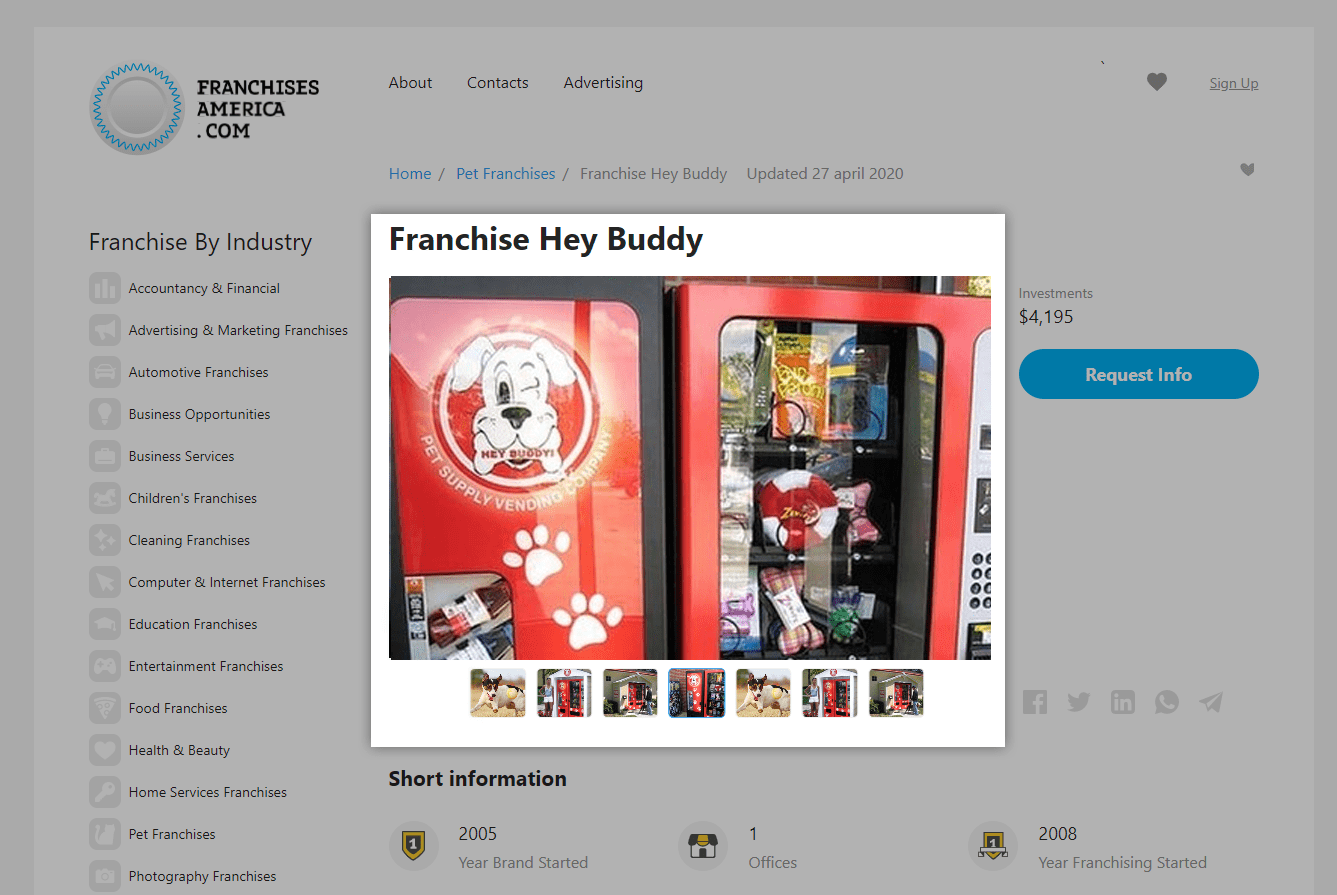
Offering drinks and snacks in a park is another great way to find vending machine locations. If you start a Hey Buddy Franchise, you can offer treats for humans and doggies in the same vending machine. Everyone will be happy when they get a treat with man’s best friend.
#22. Laundromats Need Specialty Vending Machines
Laundromats and vending machines go together like peanut butter and jelly. You can offer snack and drink machines, but don’t forget to offer products for laundry care, too. Check out Vend-Rite for vending machines specifically made for laundromats.
If you’ve ever wondered how to start a laundromat business, we’ve got a blog about that, too.
#23. RV Parks Need Vending Machines
An RV Park is a great place for a vending machine because people often need drinks, ice, snacks, or personal hygiene items while traveling. If there is an RV Park near you, see if you can provide services.
$24. Waiting Rooms: Visitors Love Vending Machines
A waiting room is a great place to put a vending machine with healthy snacks like protein bars and granola bars. You’ll probably do well with drink machines as well. Provide vending needs for people waiting for a service to be completed and make a nice profit doing it.
#25. Break Rooms: Employees Need Snacks

Employees need a place to get an easy snack or drink and a vending machine in the break room can be highly profitable. You’ll get a steady flow of revenue from these, especially in 24/7 businesses.
#26. Reception Desks Like Vending Machines
Placing a vending machine near the nurses’ desks is a great way to make a huge profit because you can serve customers, visitors, and staff all from one machine.
#27 Fire Stations Need Food And Drinks
Firefighters commonly live at their stations during their shifts. They need drinks and snacks, so make it easy for them with a vending machine.
Now that you know where to put vending machines, let’s look at how to find a vending machine location.
How to Find Vending Machine Locations

There are a ton of ways to find vending machine locations. You might want to try some of the following ideas.
- UpFlip: Buy Existing Routes
- BizBuySell: Buy Existing Routes
- Craigslist: Buy Existing Routes or Used Machines
- Vending Locator: Pay a Fee To Find Suggestions in Your Zip Code(s)
- Do Your Own Research: We’ll Show You How Next.
How to Find Locations For Vending Machine Using Business Lookups
You can look up businesses online to establish places you want to offer to put vending machines. I’m going to use Clark County, Nevada as an example. You’ll want to follow these steps:
- Find Business Lookup Site for Your City
- Review Search Options
- Search by Category, Date of License, or Zip Code
- Review Businesses
- Reach Out to Business Owners
- Visit the Location
- Provide a Vending Machine Contract Proposal
The following steps are sparsely cited because this is a strategy I use when conducting research for my consulting business. Let’s look at each step.
Find Business Lookup Site for Your City
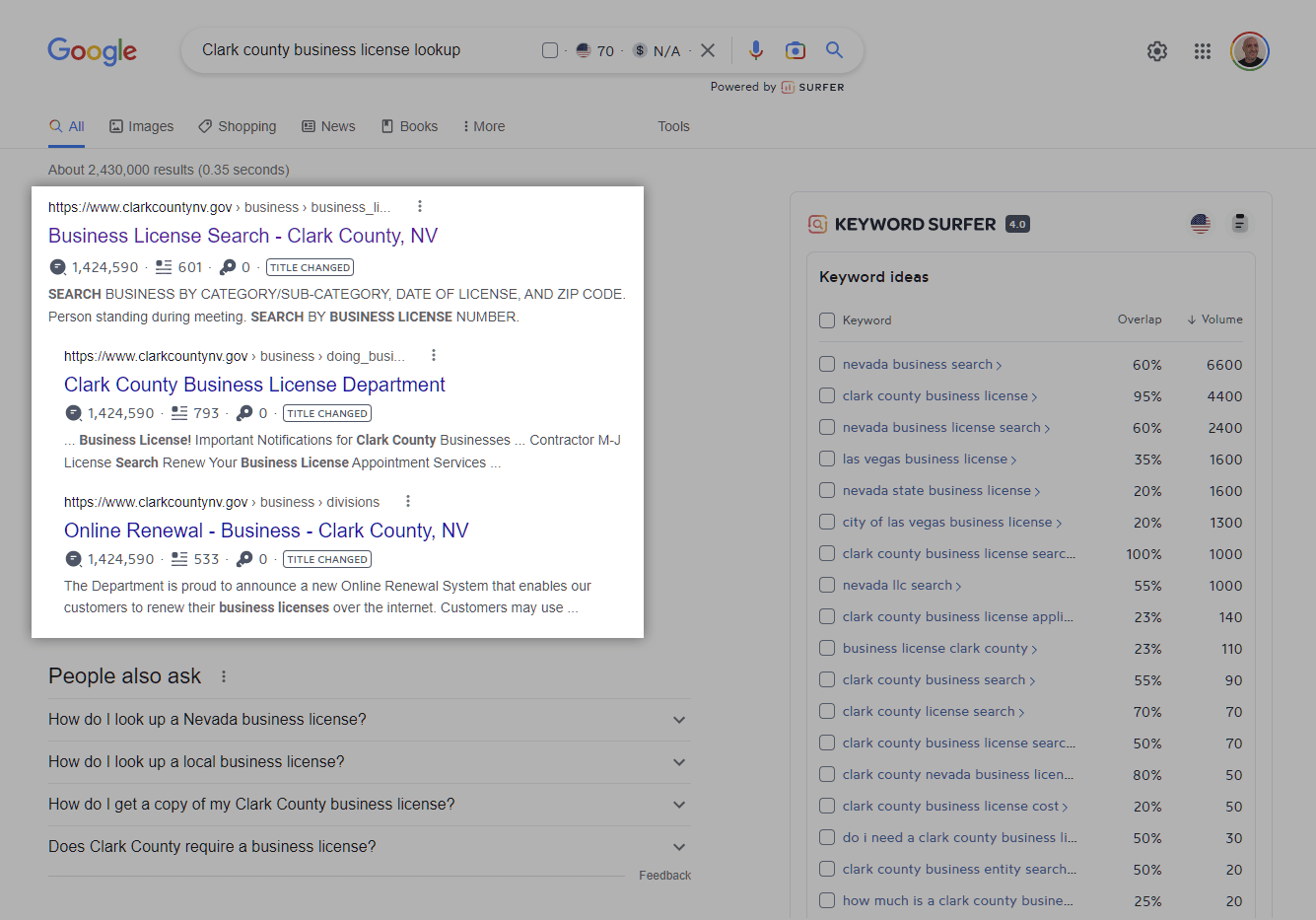
Do a quick Google Search to find your local business licensing lookup. In this example, the search would look like “Clark County business license lookup.” The results should look similar to the picture below:
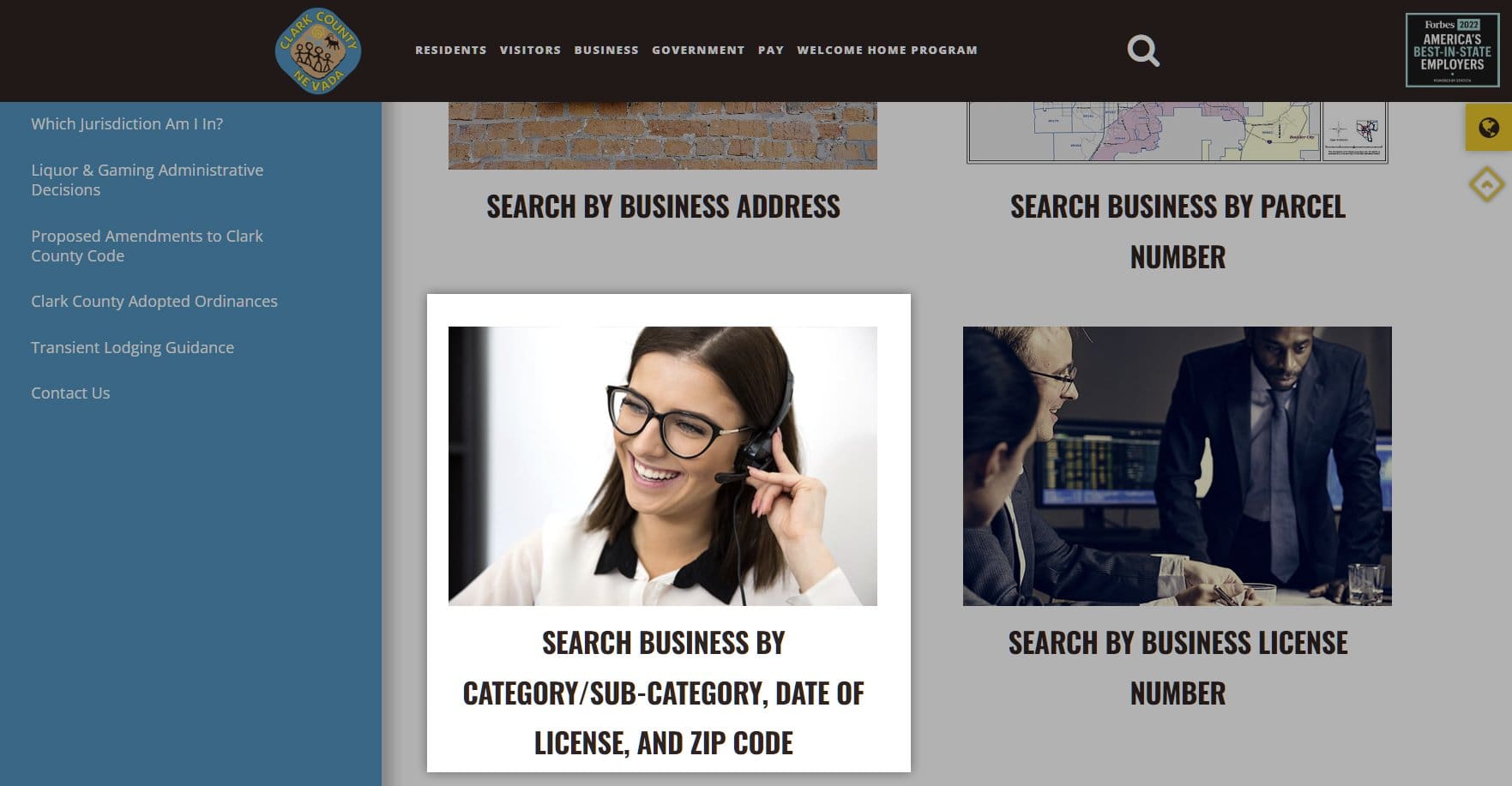
You want to make sure that it is the real site, which means look for a .gov in most scenarios. Click the link that says “Business License Search.” That will bring you to a page that will be similar to the one below:
We’ll discuss what to do here in the next step.
Review Search Options
On this step, you’ll have different ways to search for a business license including:
- Business Name: Use if you know the official business name, which is unlikely without some research.
- Business Owner: Use if you have a friend that owns businesses and you want to know where they are.
- Address of Business: Use if you know the exact address.
- Parcel Number: Use if the building is under construction and you can find the Parcel Number (normally found on signs).
- Business Category, Date of License, and Zip Code: This is the money maker. Find businesses that are in specific categories, then filter it by date and zip code.
- License Number: You’ll only know this if you have already dug into the information about a company.
Click on the “Search Business Category” option and it will take you to a page that looks like the one below:
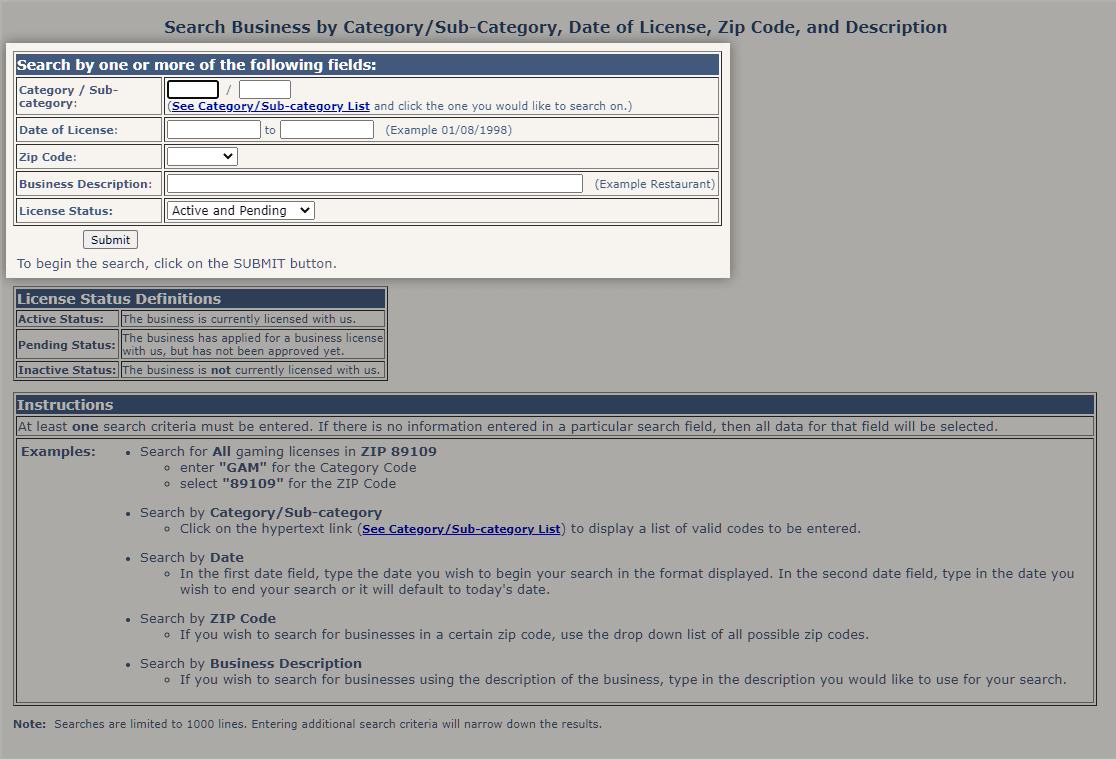
Input Category, Date of License, or Zip Code
Each state will have slightly different options, but should be similar. I’ve done this in Dallas, Las Vegas, and Seattle, where all were similar. You can fill in as many of the following fields as you want.
- Category or Sub-Category: This option narrows the field down based on the license type. I’ll use “Category 072 Sub-category 170 Transient Lodging Establishment – Hotels, Motels, and Other,” but I’d normally leave this blank at first.
- Date of License: You can put a range. The wider the range, the more results. I used from June 1 to December 31 of 2022, but I’d normally use only December.
- Zip Code: Choose one, multiple, or all locations. If you choose multiple in Nevada, you’ll need to conduct multiple searches.
- Business Description: You can input keywords to see what comes up.
- License Status: “Active,” “Active and Pending,” “Pending,” or “Inactive” are options on this page. Each state may be different.
Once you’ve put in the information, click enter and you’ll get results like the ones below. You’ll want a list of businesses to research that includes about 50-250 businesses, depending on how many machines you are trying to place. I only found six hotels so I would need some more from other categories in this example.

Next, we’ll want to review each business.
Review Businesses
If you click on one of the licenses, it will take you to the summary page, which looks like the picture below. You specifically want the address, phone number, and owners’ name from the screen. Do your research on them to find out:
- The best way to contact them.
- Personal interests, which can make it easier to connect on a personal level.
- Interesting accomplishments (also used to connect).
- Challenges they are facing (how you can help them).
Once you find enough information, it’s time to reach out to them.

Reach Out to Business Owners
Depending on the business, you can either do an email lookup, call them, or just go up there. An email or call is less expensive and might help establish if they are open to discussing your proposal. If they agree to meet with you, go visit them. If not, move on to the next business.
Visit the Location
When you visit the location, bring a:
- Vending machine contract proposal
- Literature about your machines
- Examples of how working with you will benefit them (or a document that puts your promise to them in writing)
Remember to be friendly and observe the location so you can describe where you’d put the machines and how often you’d provide service.
Provide a Vending Machine Contract Proposal
Once the property owner agrees that it makes sense to have a vending machine on their property, negotiate the terms and provide them a vending machine proposal contract. While many vending machine companies don’t like offering a percentage to the property owner, it is common to pay 5% to 20% of sales for lease of the space. Once they sign, start preparing to service their location.
Ready to Take The Next Step?
Now that you have established where to place your vending machines, it’s time to place them and provide stellar service to your customers. We’ve partnered with Adam to bring you the best information on starting a vending machine business. Sign up for our free class below:
What are your favorite vending machine locations?
- Offices
- Hospitals
- Schools
- Gyms
- Other

